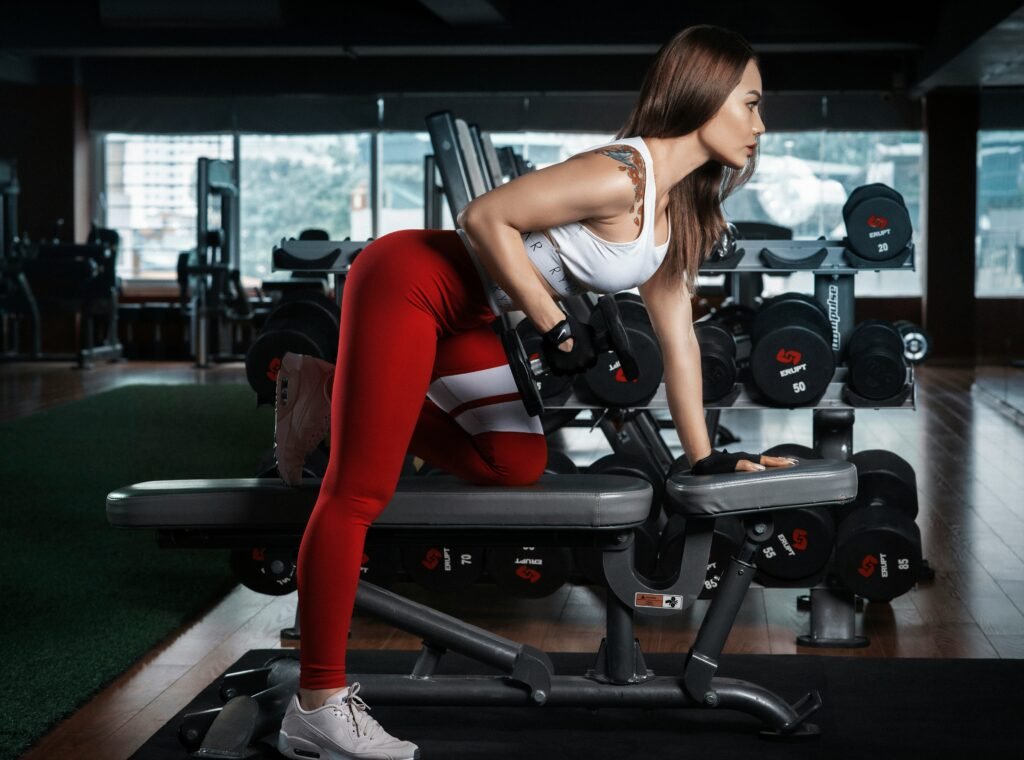
Photo by CATHY PHAM on Unsplash
Bent Over Rows are a staple in strength training routines, renowned for their effectiveness in building a thicker, stronger back. This exercise primarily targets the muscles of the upper and middle back, including the latissimus dorsi, rhomboids, and trapezius. However, it also engages the lower back, biceps, and core, making it an excellent compound movement.
The benefits of Bent Over Rows go beyond muscle building. They play a significant role in improving posture and preventing shoulder injuries. In our modern lifestyle filled with prolonged sitting and poor posture habits, exercises like Bent Over Rows are essential. Research suggests that incorporating pulling movements can counteract the negative implications of forward-leaning postures commonly seen in activities like typing or texting [^1^].
Moreover, Bent Over Rows come with various modifications. From the conventional barbell row to variations like the Pendlay Row or One-Arm Dumbbell Row, there are multiple ways to incorporate this exercise, each offering unique benefits. According to an article on Muscle & Fitness, different row variations can significantly enhance your back training by targeting muscles from various angles [^2^].
If you’re interested in learning about more row variations, check out this detailed guide on our site.
[^1^]: Muscle & Fitness [^2^]: Ibid.
Muscle Groups Targeted by Bent Over Rows

Photo by Simone Pellegrini on Unsplash
Bent over rows are a staple in strength training routines due to their efficiency in targeting multiple muscle groups in the back and beyond. The primary muscles worked during this exercise include the latissimus dorsi, trapezius, rhomboids, and posterior deltoids.
- Latissimus Dorsi: These large, wing-like muscles cover the middle and lower part of your back. They play a key role in pulling motions and are heavily engaged during the upward phase of a bent over row.
- Trapezius: The trapezius muscles span from the neck to the mid-back. Both the middle and lower portions are activated during bent over rows, helping to pull the elbows behind the torso.
- Rhomboids: Located between the shoulder blades, the rhomboids retract the scapulae, contributing to the rowing motion and improving shoulder stability.
- Posterior Deltoids: These muscles are located on the back of the shoulder and are mainly responsible for shoulder extension. They work in tandem with other back muscles to lift the weight during the row.
In addition to these primary muscles, the bent over row also calls upon the hip extensors and core stabilizers to maintain the proper bent-over position. This static use of the hip extensors, similar to what’s required during a deadlift, helps ensure stability and proper form (source).
For more exercises that target similar muscle groups, you might find our article on back exercises with barbell very useful.
Step-by-Step Guide to Performing Bent Over Rows
Step-by-Step Guide to Performing Bent Over Rows
- Performing bent over rows correctly is essential for maximizing gains and minimizing the risk of injury. Here’s a step-by-step guide to ensure you get the most out of this effective back exercise:
Setup and Starting Position
- 1. Equipment: You will need a barbell or a pair of dumbbells.
- 2. Grip: Hold onto the barbell with an overhand grip, palms facing down.
- 3. Stance: Bend your knees slightly and hinge forward at the waist. Your back should remain straight and be almost parallel to the floor.
- 4. Position: The barbell should be in front of you, with your arms hanging straight down, perpendicular to the floor. This is your starting position.
Lifting the Barbell
- 1. Movement: While keeping your torso stationary, lift the barbell toward your body. Focus on using your back muscles rather than your arms.
- 2. Form: Ensure your elbows stay close to your body, and only your forearms move to hold the weight.
- 3. Peak Contraction: When the barbell is close to your torso, squeeze your shoulder blades together and hold this position for a brief moment.
Lowering the Barbell
- 1. Descent: Slowly lower the barbell back to the starting position, keeping your movements controlled to maintain form.
- 2. Repetitions: Repeat this process for the desired number of repetitions in your workout routine.
Safety and Tips
- Head Position: Keep your head up and inline with your spine throughout the exercise to avoid any risk of neck strain.
- Avoid Slouching: Ensure your back remains straight and avoid slouching, as improper form can lead to back injuries.
- Focus on Form: Obtain proper form before increasing weights. Proper technique ensures maximum effectiveness and reduces injury risk ([source](https://www.exercise.com/exercises/bent-over-row/)).
- For more detailed back workout techniques, you might find our article on [Back Exercises With Barbell](https://thefitnessboard.com/back-exercises-with-barbell/) helpful.
Common Mistakes to Avoid
When performing bent over rows, it’s easy to make errors that can affect the effectiveness of the exercise and lead to injury. Here are some common mistakes to avoid:
- Rounding Your Back: One of the most frequent errors is rounding the back instead of maintaining a straight or slightly arched lower back. This mistake can place unnecessary stress on your spine and increase the risk of injury. Always keep a neutral spine and engage your core throughout the movement.
- Using Too Much Weight: Lifting too heavy can compromise your form. According to strength and conditioning experts, lifting too much weight can lead to improper technique, making you more prone to injuries (Healthline). Start with a manageable weight and focus on proper form before gradually increasing the load.
- Pulling with Your Arms Instead of Your Back: Many people tend to pull the weight using their biceps rather than engaging their back muscles. This not only limits the workout’s effectiveness but also increases injury risk. Concentrate on squeezing your shoulder blades together and lifting the weight with your back muscles.
- Improper Use of Momentum: Using momentum to lift the weight, such as jerking or swinging, reduces the exercise’s effectiveness and can lead to strains. Aim for controlled movements by lifting and lowering the weight slowly. This ensures that your back muscles are doing the work (Citation: Avoiding Common Mistakes).
- Incorrect Foot Position: Placing your feet too wide or too narrow can destabilize you and affect your form. Your feet should be shoulder-width apart, and your knees slightly bent to help distribute the weight evenly and provide stability during the exercise.
For more on how to maintain good form and avoid common mistakes during other types of workouts, check out our article on Steady State Cardio Examples.
Training Tips for Maximum Gains
To get the best results from your bent over rows, focus on the key mechanisms of muscle growth: mechanical tension, metabolic stress, and muscular damage. These three factors work together to maximize muscle gains.
- Mechanical Tension: Use a substantial load and perform exercises with the full range of motion. Aim for 3-5 sets of 3-6 reps using heavy weights. This not only increases mechanical tension but also ensures you’re building a strong foundation which is crucial for muscle growth. Brad Schoenfeld highlights that greater strength leads to more mechanical tension (source).
- Metabolic Stress: Incorporate high-rep exercises at the end of your workout to achieve a good pump. Perform exercises in the range of 12-25 reps per set. This causes an accumulation of metabolites such as lactate, leading to hypertrophy. Keep the rest periods short, around 1 minute between sets, to maintain metabolic stress.
- Muscular Damage: Intentionally slow down the eccentric phase of your rows and use exercises your body isn’t accustomed to. This induces muscular damage, which in turn signals the body to repair and grow stronger. Keep in mind that while some soreness is indicative of muscle damage, excessive damage can hinder your training frequency.
Combining these tips will help optimize your training routine and bring you closer to your muscle-building goals. If you’re also looking to improve your overall cardiovascular health, consider checking out our guide on zone 2 cardio.
Integrating Bent Over Rows into Your Workout Routine
Incorporating bent over rows into your workout routine can offer significant benefits, particularly for those looking to enhance their back strength and overall upper body conditioning. This exercise targets a multitude of muscle groups including the traps, rhomboids, lats, spinal erectors, as well as the biceps and forearms. With such a wide range of muscles engaged, bent over rows are considered one of the most effective movements for developing a strong and thick back.
To integrate bent over rows into your routine, aim for variety in your approach. You can perform the exercise with a strict form using higher repetitions (8–10 reps per set) to focus more on endurance and muscle engagement. Alternatively, you may choose a heavier weight with slight momentum for lower repetitions (3–6 reps per set) to build maximum strength. According to strength training experts, incorporating a mix of these rep ranges helps in building both muscle size and strength (Quora).
A practical way to start is by scheduling the bent over row on your back or pull workout days. This exercise can act as a primary or accessory movement, assisting in other lifts like the deadlift by strengthening the same muscle groups involved. For example, performing bent over rows once a week while deadlifting twice a week (one regular and one Romanian deadlift session) can yield balanced strength gains and improved performance across these exercises.
For those concerned with recovery and frequency, consult guides on workout planning such as our article on how long to wait to do cardio after lifting weights. Proper spacing and exercise variety can help you optimize your training and avoid overtraining.
Practical Tips and Tricks
1. Warm-Up First: Before engaging in bent over rows or any heavy lifting, a proper warm-up is essential. This not only helps prevent injury but also prepares your muscles for the workout. Spend at least 10 minutes warming up with light cardio and dynamic stretches focusing on your shoulders and back.
2. Use Correct Weight: Start with a weight that allows you to perform each rep with perfect form. Using too heavy a weight can compromise your technique, leading to injuries. Aim for a weight that enables you to complete 8-12 reps comfortably.
3. Mind Your Grip: Your grip can influence muscle engagement. An underhand (supinated) grip tends to target the lower lats more, while an overhand (pronated) grip engages the upper back effectively. Experiment with both to see what works best for you.
4. Keep Your Back Straight: Maintaining a neutral spine is crucial. A rounded back not only minimizes muscle engagement but also increases the risk of injury. Focus on keeping your chest out and shoulders back throughout the movement.
5. Controlled Movements: Perform the exercise in a slow and controlled manner, especially during the lowering phase. This ensures muscle activation and growth. According to research, “eccentric (lowering) movements can induce more muscle damage, leading to greater muscle hypertrophy” (source: Restless).
6. Breathe Properly: Effective breathing can increase your stamina and strength. Exhale as you lift the weight towards your torso and inhale as you lower it back down.
7. Incorporate Variations: To prevent plateaus and keep your muscles guessing, incorporate different bent over row variations into your routine. For example, single-arm dumbbell rows can improve your muscle imbalances.
8. Pair with Other Exercises: Bent over rows pair well with other compound movements like deadlifts or squats. You can learn more about pairing routines and maximizing muscle gains in our detailed guide on at-home dumbbell back workouts.
By following these practical tips, you’ll not only improve your bent over row technique but also maximize your muscle gains while minimizing the risk of injury.